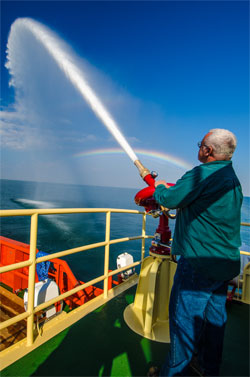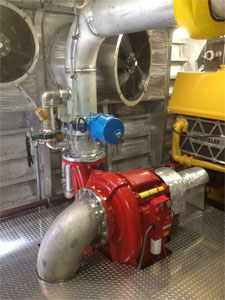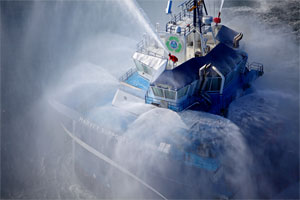For Glynn Grantham, the proof that the Deepwater Horizon disaster has generated attention on improving fire safety offshore can be seen in the numbers.
“I’ve been doing this for 35 years, and we’ve typically had about 12 projects a year,” said Grantham, owner of In-Mar Systems of Gonzales, La., a distributor and installer of fire monitor systems for the maritime industry. “I have 60 projects going on right now, so that kind of gives you an indication. And it’s all after the Horizon explosion.”
 |
|
Brian Gauvin |
|
Jerry Boudreaux, a Breaux Brothers employee, operates an Elkhart Giant Python fire monitor aboard the offshore supply vessel Fast Hauler. |
Grantham said all 60 projects involve offshore supply vessels (OSVs) and the installation of FiFi-rated systems, most of them FiFi Class I. He estimated that before the Deepwater Horizon incident in 2010, only about 25 percent of OSVs had FiFi-rated systems. Now, virtually all newly built OSVs are getting them, and the retrofit market is active as well.
“It’s just now that the oil companies are asking for all of the boats to have this equipment,” Grantham said. “As far as I know, it’s not being driven by regulations. It’s for economic reasons — they’re protecting an investment — and for safety. I think it’s a combination of the two.”
Fire monitors are the manually or remote-controlled water cannons on deck, the most visible component of the system. The heart is the pumps, which are installed below deck on new-builds and are driven by the main engines, a dedicated engine or electric motors. Retrofit systems for existing vessels are housed on the main deck. They typically are containerized units that include a pump and a diesel engine to drive it.
The FiFi standards dictate water discharge rates, capacity and range. FiFi Class I requires a vessel to have two monitors that can each discharge 5,280 gallons of water per minute, with a range of 394 feet.
“To reach some of these huge oil platforms, it takes a lot of water and a lot of pressure, so ABS (the American Bureau of Shipping) categorized it and said if you want FiFi-I, you’ve got to throw it 120 meters,” said Grantham, whose company distributes products made by Fire Fighting Systems (FFS) and Nijhuis. “For FiFi-II, you’ve got to throw it 150 meters, and it goes up from there.”
Charles Ronie, president and chief executive of Stang Industries, a Corona, Calif.-based manufacturer and designer of fire monitoring systems, said his company also has seen an increase in demand for FiFi equipment after Deepwater Horizon. Stang’s CounterFire division handles the OSV market.
“We’ve seen more activity as far as on-deck systems, the retrofits,” he said. “If you want to take a boat from no firefighting capacity to complete FiFi-I capacity, the way you do it is through an on-deck portable system.”
Ronie said domestic customers also have been expressing more interest in FiFi-II packages, which in the past have been more common overseas than in the United States.
“We have seen an increase in FiFi-IIs, and I think that might be because of what happened with the Deepwater Horizon,” he said. “Because FiFi-II is going to shoot farther, it’s going to stretch that shot out and you’re going to get the boat farther away from the heat source.”
Grantham said the willingness of operators to add FiFi equipment is a reflection of a greater return in the offshore marketplace.
“By the time the whole thing is done, it can cost $1 million to install a complete FiFi system with electric motors or driving it off the front of the engines, so you’re looking at a fair chunk of money,” he said. “Typically, owners or supply-boat leasing companies are not just going to put $1 million of equipment on and not get money for it. What happens is these owner/operators go to the oil companies and say, ‘I have a FiFi system on, so my boat is X number of dollars.’ And they get more money for the boat.”
 |
|
Courtesy In-Mar Systems A pump clutch all-in-one unit, part of a fixed firefighting system, within the engine room of a crew boat. |
Andre Dubroc, general manager for Master Boat Builders of Coden, Ala., said the safety equation is producing FiFi work that his company hadn’t seen before.
“We had never built any FiFi-rated vessels here, but I have a contract to build three right now,” he said. “If the end user wants it, they pay more for it. That’s how it comes down the line.”
Ronie said manufacturers are continually striving to improve the efficiency of pumps and monitors, enabling the systems to shoot farther and more accurately at a moment’s notice.
“What most people don’t realize is that most of the time, the monitors are not doing anything,” he said. “You test them once a month to make sure they work, and on many vessels that’s basically what they do for their life span. But when that one (fire) event happens and lives are at stake, (monitors) are necessary to put it out. If you don’t have them, you’re stuck. And wasn’t that the wrong decision not to have them on your boat.”

